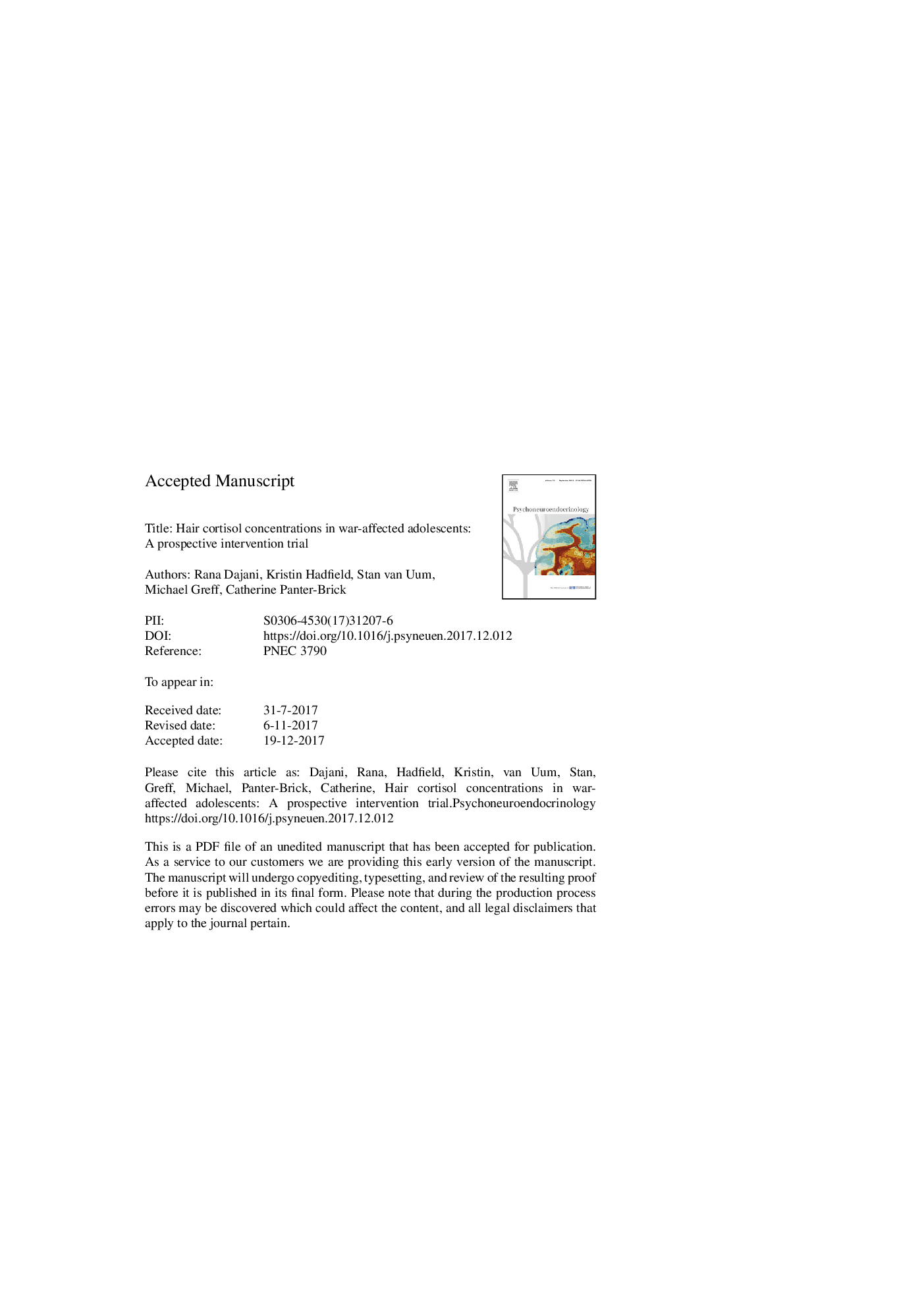| کد مقاله | کد نشریه | سال انتشار | مقاله انگلیسی | نسخه تمام متن |
|---|---|---|---|---|
| 6817769 | 1433954 | 2018 | 36 صفحه PDF | دانلود رایگان |
عنوان انگلیسی مقاله ISI
Hair cortisol concentrations in war-affected adolescents: A prospective intervention trial
ترجمه فارسی عنوان
غلظت کورتیزول مو در نوجوانان مبتلا به جنگ: یک آزمایش مداخله ای آینده نگر
دانلود مقاله + سفارش ترجمه
دانلود مقاله ISI انگلیسی
رایگان برای ایرانیان
کلمات کلیدی
biological sensitivity to contextrandomized control trial - آزمایش تصادفی کنترلPTSD - اختلال استرسی پس از ضایعه روانیstress responsivity - استرس پاسخگوییStress - استرس یا فشار روانیhypercortisolism - بیش از حد کورتیزولیBiomarker - بیومارکرTrauma - تروماForced displacement - جابجایی اجباریSyria - سوریهHypothalamic-pituitary-adrenal axis - محور هیپوتالاموس-هیپوفیز-آدرنالIntervention - مداخلهGrowth model - مدل رشدAdolescent - نوجوانیHypocortisolism - هیپوکورتیزولیزمRefugee - پناهندهHair cortisol - کورتیزول مو
موضوعات مرتبط
علوم زیستی و بیوفناوری
بیوشیمی، ژنتیک و زیست شناسی مولکولی
علوم غدد
چکیده انگلیسی
Temporal examinations of the biological signature of stress or trauma in war-affected populations are seldom undertaken. Moreover, few studies have examined whether stress biomarkers track biological sensitivity to brief interventions targeting the improvement of psychosocial wellbeing. Our study is the first to prospectively examine, in war-affected adolescents, the associations between hair cortisol concentrations (HCC) and self-reports of stress, insecurity, posttraumatic reactions, and lifetime trauma. We conducted a randomized controlled trial to test the impact of an 8-week intervention based on profound stress attunement. We collected data for a gender-balanced sample of 733 Syrian refugee (nâ¯=â¯411) and Jordanian non-refugee (nâ¯=â¯322) adolescents (12-18 years), at three time-points. We used growth mixture models to classify cortisol trajectories, and growth models to evaluate intervention impact on stress physiology. We observed three trajectories of HCC: hypersecretion, medium secretion, and hyposecretion (9.6%, 87.5% and 2.9% of the cohort, respectively). For every one percent increase in levels of insecurity, adolescents were 0.02 times more likely to have a trajectory of hypersecretion (95% CI: 1.00, 1.03, pâ¯=â¯0.01). For each additional symptom of posttraumatic stress reported, they were 0.07 times less likely to show hyposecretion (95% CI: 0.89, 0.98, pâ¯=â¯0.01). Indeed, stronger posttraumatic stress reactions were associated with a pattern of within-individual cortisol dysregulation and medium secretion. Overall, HCC decreased by a third in response to the intervention (95% CI: â0.19, â0.03, pâ¯=â¯0.01). While the intervention decreased HCC for youth with hypersecretion and medium secretion, it increased HCC for youth with hyposecretion (95% CI: 0.22, 1.16, pâ¯=â¯0.004), relative to controls. This suggests a beneficial regularization of cortisol levels, corroborating self-reports of improved psychosocial wellbeing. We did not find evidence to suggest that gender, resilience, or posttraumatic stress disorder influenced the strength or direction of responses to the intervention. This robust impact evaluation exemplifies the utility of biomarkers for tracking physiological changes in response to interventions over time. It enhances the understanding of trajectories of endocrine response in adverse environments and patterns of stress responsivity to ecological improvement.
ناشر
Database: Elsevier - ScienceDirect (ساینس دایرکت)
Journal: Psychoneuroendocrinology - Volume 89, March 2018, Pages 138-146
Journal: Psychoneuroendocrinology - Volume 89, March 2018, Pages 138-146
نویسندگان
Rana Dajani, Kristin Hadfield, Stan van Uum, Michael Greff, Catherine Panter-Brick,
